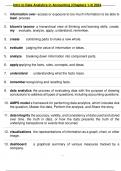Intro to Data Analytics in Accounting (Chapters 1-4) 2024
1. information over- access or exposure to too much information to be able to
load process
2. bloom's taxono- a hierarchical view of thinking and learning skills. create,
my evaluate, analyze, apply, understand, remember.
3. create combining parts to make a new whole.
4. evaluate judging the value of information or ideas.
5. analyze breaking down information into component parts.
6. apply applying the facts, rules, concepts, and ideas.
7. understand understanding what the facts mean.
8. remember recognizing and recalling facts.
9. data analytics the process of evaluating data with the purpose of drawing
conclusions to address all types of questions, including accounting questions.
10. AMPS model a framework for performing data analytics, which includes Ask
the question, Master the data, Perform the analysis, and Share the story.
11. data integrity the accuracy, validity, and consistency of data used and stored
over time. the truth in data, or how the data presents the truth of the
underlying transactions or events that occurred.
12. visualizations the representations of information as a graph, chart, or other
image.
13. dashboard a graphical summary of various measures tracked by a
company.
1/7
, 15. dynamic characterized by constant update, change, or activity.
Intro to Data Analytics in Accounting (Chapters 1-4) 2024
16. pivottables a tool that allows reorganization and summarization of
certain data using crosstabulations without changing the underlying
spreadsheet or data.
17. accounting data the technologies, systems, practices, methodologies,
analytics databases, statistics, and applications used to analyze
diverse accounting and nonaccounting data to give
organizations the information they need to make sound
and timely business decisions.
18. audit an assessment of the accounting principles used and
significant estimates made; it evaluates the overall
financial statement presentation.
19. big data datasets that are too large and complex for businesses'
existing systems (traditional capabilities) to capture,
store, manage, and analyze.
20. structured data highly organized data that fits nicely in a table or in a
database. an excel spreadsheet, or balance sheet or
income statement in a good example.
21. unstructured data data without internal organization or structure. blogs and
social media and pictures posted in Instagram would both
be examples.
22. semi structured data without internal organization or structure but that has
data tags explaining what the data represents. ex: XBRL.
23. veracity the underlying quality of the data, as to whether the data
is true or accurate or clean and is worthy of trust.
24. financialany information external decision makers, such as
accounting data stockholders, banks, and suppliers, might use to help
make decisions.
25. financial statements
2/7





